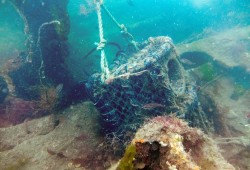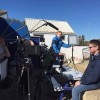CHASM Project Report 2020-2021

Since early 2020 the first stages of a project concentrating on lobsters and sediment has been taking place in the seas surrounding the Manhood Peninsula south of Chichester, West Sussex, notably near Selsey Bill and Bracklesham Bay. This is the CHASM Project (CHASM | Manhood Peninsula Partnership). The acronym stands for Crustaceans, Habitat And Sediment Movement.
The project began following Sea’s the Day (Sea’s the Day | Manhood Peninsula Partnership), during which questions were raised by the fishermen of Selsey Bill with respect to why so few lobsters were being caught locally, and why such a large influx of sediment had arrived in their fishing grounds.
The initial stages were undertaken by Channel Coast Observatory and University of Brighton. The aim was to review existing data in order to establish a baseline indicating knowledge gaps, and in doing so, show the direction of travel necessary for future work. This forms the basis of the first CHASM Report 2020-2021.
The report doesn’t aim to draw conclusions with respect to the definitive reasons behind environmental change and lobster decline - this will be a long road, on which we have only just embarked. It has served to direct our thoughts on next steps however, and there is a whole list of subject areas to be explored from now on that should finally be able to provide an answer.
The project is slowly changing emphasis, and instead of looking only at crabs and lobsters, is beginning to look more closely at the seawater and seabed they inhabit. In addition, water quality and environmental change are both affected by factors such as climate change and intense urbanisation on the south coast and in temperate zones generally. It is essential to gain knowledge of why lobsters declined, and sediment conditions changed before determining whether it is possible to restore the previous status quo.
One of the main points to emphasise is that this is a review of existing data with, and the analysis of only a very small amount of new sediment data was possible. Covid was not our friend in this respect, but since laboratories reopened analysis work has restarted and will be reported on in due course.
It is hoped that the ongoing research will benefit other projects on the south coast but will also prove an effective model to roll out to other temperate regions.
Key partners in the report are the Manhood Peninsula Partnership, Channel Coast Observatory, University of Brighton, and Chichester District Council. A huge amount of support was received during the period covered by the report from the fishermen of Selsey Bill, and project partners Mulberry-ME, and Southsea SAC to whom huge thanks are due.
Please download the report below:
CHASM Project Report (2020 – 2021)
Sea's the Day
The ‘Sea’s the Day’ project was a partnership project between Selsey Town Council, Chichester District Council and the Fishermen of Selsey Bill. The project aimed to raise the profile of Selsey’s fishing industry in a historical context, but also to emphasise pressures on the current fishing industry from the perspectives of a changing economic scene and a changing climate.... Read More»
ICZM 2011 - Coastal Change Pathfinder
In late 2009 the Government awarded £11 million in grants to local authorities who demonstrated the best and most innovative ideas for dealing with and adapting to coastal change. To its delight, Chichester District Council was awarded £450,000 and and became part of the Coastal Change Pathfinder Project. The project began properly in May 2010 and continued until the end of June 2011. A total... Read More»
Sea's The Day Film

Sea's the Day: The Fishermen of Selsey Bill. The film is one of the high points of the project. Millstream Productions did a wonderful job as they worked with the project team to sift through the oral history interviews to identify likely candidates to sit in front of a camera. This was followed by filmed interviews at locations on... Read More»